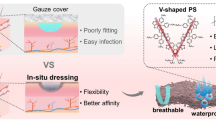Abstract
Prevention of infection at the surgical area and outbreak of wounds are the most important and at the same time challenging tasks in clinical care. This research investigates the healing effect of laparotomy wounds after the use of bio-fabricated gold nanoparticles (Au NPs) prepared utilizing Thuja occidentalis leaf extract. Ultraviolet–visible (UV–Vis) spectroscopy and X-ray diffraction (X-RD) results confirmed the successful formation of Au NPs. High-resolution Transmission Electron Microscopy (HR-TEM) images confirmed the formation of spherical shaped Au NPs comprising of 30–50 nm particle size. Dermal fibroblasts were subjected to increased concentrations of Au NPs and their effect of cytotoxicity and synthesis of collagen was evaluated. The procedure of celiotomy was conducted on rabbits where the surgical area was exposed topically with either vehicle or once/everyday with Au NPs for about 14 days. Au NPs raised the collagen production from dermal fibroblasts and improved the expression of caspase 3 by exposure to a long period. AuNPs also showed cytotoxic impact with half-maximal inhibitory concentration (IC50) of 0.16 mg/mL. Regular treatment of surgical area with AuNPs led to higher collagen deposition with reduced microbial load and enhanced healing of wounds.











Similar content being viewed by others
References
Arhi C, El-Gaddal A (2013) Use of a silver dressing for management of an open abdominal wound complicated by an enterocutaneous fistula from hospital to community. J Wound Ostomy Continence Nurs 40:101–103
Chueh PJ, Liang RY, Lee YH, Zeng ZM, Chuang SM (2014) Differential cytotoxic effects of gold nanoparticles in different mammalian cell lines. J Hazard Mater 264:303–312
Geetha R, Ashokkumar T, Tamilselvan S, Govindaraju K, Sadiq MD, Singaravelu G (2013) Green synthesis of gold nanoparticles and their anticancer activity. Cancer Nano 4:91–98
Heller L, Levin S, Butler C (2006) Management of abdominal wound dehiscence using vacuum assisted closure in patients with compromised healing. Am J Surg 191:165–172
Hugh TB (1990) Abdominal wound dehiscence, editorial comment. Aust NZ J Surgery 60:153–155
Jo MR, Yu J, Kim HJ, Song JH, Kim KM, Oh JM, Choi SJ (2016) Titanium dioxide nanoparticle-biomolecule interactions influence oral absorption. Nanomaterials (Basel) 6:225
Koohi MK, Hejazy M, Asadi F, Asadian P (2011) Assessment of dermal exposure and histopathologic changes of different sized nanosilver in healthy adult rabbits. J Phys Conf Ser 304:012028
Kwan KH, Liu X, To MK, Yeung KW, Ho CM, Wong KK (2011) Modulation of collagen alignment by silver nanoparticles results in better mechanical properties in wound healing. Nanomed: Nanotechnol Biol Med 7:497–504
Liu HL, Dai SA, Fu KY, Hsu SH (2010) Antibacterial properties of silver nanoparticles in three different sizes and their nanocomposites with a new waterborne polyurethane. Int J Nanomed 5:1017–1028
Mawalla B, Stephen EM, Phillipo LC, Can I, William M (2011) Predictors of surgical site infections among patients undergoing major surgery at Bugando Medical Centre in Northwestern Tanzania. BMC Surgery 11:21
Mohamad NAN, Arham NA, Jai J, Had A (2013) Plant extract as reducing agent in synthesis of metallic nanoparticles: a review. AMR 832:350–355
Mokela JI, Kiviniemi H, Juvonen T, Laitinen S (1995) Factors influencing wound dehiscence after midline laparotomy. Am J Surg 170:387–390
Pal S, Tak YK, Song JM (2007) Does the antibacterial activity of Silver nanoparticles depend on the shape of the nanoparticle? A study of the gram-negative bacterium Escherichia coli. Appl Environ Microbiol 73:1712–1720
Spiliotis J, Tsiveriotis K, Datsis AD, Vaxevanidou A, Zacharis G, Giafis K, Kekelos S, Rogdakis A (2009) Wound dehiscence: is still a problem in the 21th century: a retrospective study. World J Emerg Surg 4:12
Vijayan R, Siby J, Beena M (2018) Indigofera tinctoria leaf extract mediated green synthesis of silver and gold nanoparticles and assessment of their anticancer, antimicrobial, antioxidant and catalytic properties. Artif Cells Nanomed Biotechnol 46:861–871
Author information
Authors and Affiliations
Corresponding author
Additional information
Publisher's Note
Springer Nature remains neutral with regard to jurisdictional claims in published maps and institutional affiliations.
Rights and permissions
About this article
Cite this article
Dong, Y., Hu, XM., Cao, YF. et al. Thuja occidentalis mediated AuNPs as wound dressing agents for abdominal wound healing in nursing care after surgery. Appl Nanosci 10, 3577–3584 (2020). https://doi.org/10.1007/s13204-020-01459-y
Received:
Accepted:
Published:
Issue Date:
DOI: https://doi.org/10.1007/s13204-020-01459-y




